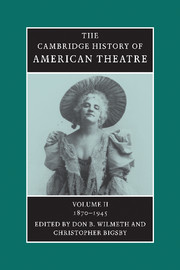Book contents
- Frontmatter
- Introduction
- Timeline: Post-Civil War to 1945
- 1 The Hieroglyphic Stage: American Theatre and Society, Post-Civil War to 1945
- 2 A Changing Theatre: New York and Beyond
- 3 Plays and Playwrights
- 4 Theatre Groups and Their Playwrights
- 5 Popular Entertainment
- 6 Musical Theatre
- 7 Actors and Acting
- 8 Scenography, Stagecraft, and Architecture
- 9 Directors and Direction
- Bibliography
- Index
6 - Musical Theatre
Published online by Cambridge University Press: 28 March 2008
- Frontmatter
- Introduction
- Timeline: Post-Civil War to 1945
- 1 The Hieroglyphic Stage: American Theatre and Society, Post-Civil War to 1945
- 2 A Changing Theatre: New York and Beyond
- 3 Plays and Playwrights
- 4 Theatre Groups and Their Playwrights
- 5 Popular Entertainment
- 6 Musical Theatre
- 7 Actors and Acting
- 8 Scenography, Stagecraft, and Architecture
- 9 Directors and Direction
- Bibliography
- Index
Summary
Introduction
Secular theatricals of various kinds became established in America about a century after the arrival of European colonists on the Atlantic coast and the Gulf of Mexico. Many, if not most, theatre pieces presented from the 1700s and early 1800s included music in some form, although the absence of a generous system of patronage prevented the wholesale importation of the materials required to mount major European works for the stage. Spanish informants described the playing of religious theatricals with music for Native Americans in Mexico in the middle of the sixteenth century. The presence of dances that originated in the New World were already being discussed in Spain in the 1590s. Because drama continued to flourish in the seventeenth century, during the golden age of Spanish culture, the plays of Lope de Vega and Pedro Calderon de la Barca were probably performed with their incidental music in the Spanish colonies during the 1600s and 1700s, although surviving musical evidence is sparser than one might hope. A play, entitled El Rodrigo, set to music by Mexican Manuel de Zumaya (c. 1678-1750), was probably mounted in 1708, and La partenope, a three-act opera also by Zumaya (based on Stampiglia’s libretto, later used by Handel) greatly pleased the vice-regal authorities in Mexico City in 1711, well before any English and other continental works – ballad operas, Italian operas translated into English, English plays with spoken dialogue and songs, French melodramas (plays that used music to accompany action) – had been successfully transplanted.
- Type
- Chapter
- Information
- The Cambridge History of American Theatre , pp. 411 - 445Publisher: Cambridge University PressPrint publication year: 1999



